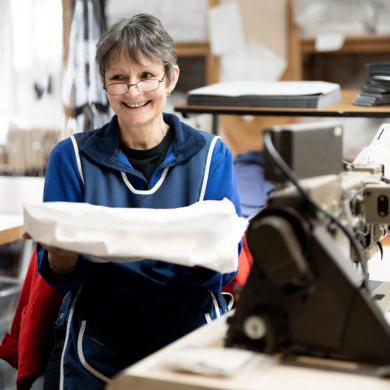
Winterdepressionen entlarven: Ihr 16-Schritte-Leitfaden für einen schöneren Winter
Wenn die Blätter fallen und die Tage kürzer werden, verspüren viele von uns die ersten Anzeichen von Winterdepressionen. Dieses Gefühl ist mehr als nur Abneigung gegen die Kälte; es handelt sich um eine Form der Depression, die als saisonale affektive Störung (SAD) bekannt ist und im Diagnostischen und Statistischen Handbuch Psychischer Störungen (DSM-5) detailliert beschrieben wird.
Die saisonale affektive Störung (SAD) tritt häufig in den Herbst- und Wintermonaten auf und steht im Zusammenhang mit dem Rückgang des natürlichen Sonnenlichts.
Aber verzweifeln Sie nicht; dieser Beitrag wird Ihnen 16 Strategien aufzeigen, die Ihnen helfen, die saisonale Depression effektiv zu bekämpfen.
1. Es werde Licht: Investieren Sie in eine Lichttherapiebox

Bildnachweis: Rohbilder von Pixabay
Lichttherapieboxen, auch Phototherapieboxen genannt, sind Geräte, die das Tageslicht imitieren. Sie erzeugen ein helles Licht, das in der Regel um ein Vielfaches stärker ist als normale Innenbeleuchtung.
Die Idee hinter der Verwendung einer Lichttherapiebox ist, das in den Herbst- und Wintermonaten verminderte Sonnenlicht zu ersetzen und die innere biologische Uhr (oder den zirkadianen Rhythmus) des Körpers zu regulieren.
Das Licht dieser Boxen ist deutlich heller als das von herkömmlichen Glüh- oder Leuchtstofflampen.
Auch wenn die Exposition gegenüber solch hellem Licht zunächst abschreckend wirken mag, ist es gerade diese Intensität, die dazu beitragen kann, den Schlaf-Wach-Rhythmus des Körpers zu regulieren und die innere Uhr zurückzusetzen.
Wenn Sie in der Nähe einer Lichttherapiebox sitzen – das Gerät sollte sich auf Augenhöhe und seitlich befinden, um Blendung zu vermeiden –, gibt es Licht ab, das natürliches Tageslicht imitiert. Man geht davon aus, dass diese Art der Lichtexposition die für die Stimmung relevanten Botenstoffe im Gehirn beeinflusst und so die Symptome der saisonalen affektiven Störung (SAD) lindert.
Die Anwendung einer Lichttherapiebox kann auch bei anderen Formen von Depressionen, Schlafstörungen und anderen Erkrankungen hilfreich sein.
Wichtig ist, dass bei der Lichttherapie Zeitpunkt, Dauer und Regelmäßigkeit entscheidend sind. Üblicherweise verwendet man eine Lichttherapielampe etwa 20–30 Minuten täglich, idealerweise morgens.
Allerdings können Zeitpunkt und Dauer variieren, daher ist es ratsam, vor Beginn der Lichttherapie einen Arzt zu konsultieren.
Außerdem sind nicht alle Lichttherapiegeräte gleich. Manche geben höhere Mengen an UV-Licht ab, was schädlich sein kann. Achten Sie daher auf ein Lichttherapiegerät, das möglichst wenig UV-Licht abgibt.
Abschließend lässt sich sagen, dass Lichttherapie zwar eine wirksame Behandlungsmöglichkeit bei saisonaler Depression sein kann, aber nicht für jeden geeignet ist. Bei manchen Menschen kann sie zu Augenbelastung, Kopfschmerzen oder, bei Personen mit bipolarer Störung, sogar zu manischen Episoden führen.
Wie immer ist es unerlässlich, jede neue Behandlung mit einem Arzt oder einer anderen medizinischen Fachkraft zu besprechen, um sicherzustellen, dass es sich um eine sichere und wirksame Option für Sie handelt.
2. Genieße das Tageslicht
Selbst an bewölkten Tagen kann ein Aufenthalt im Freien während des Tages die Stimmung deutlich verbessern.

Bildnachweis: Jill Wellington, Pixabay
Körperliche Aktivität ist ein wirksames Mittel gegen saisonale Depressionen. Dabei geht es nicht nur um die körperlichen Vorteile; Sport kann sich auch positiv auf die psychische Gesundheit auswirken, indem er den Serotoninspiegel erhöht und dadurch die Stimmung hebt.
Serotonin ist ein Neurotransmitter, der eine entscheidende Rolle bei der Regulierung von Stimmung, Schlaf, Appetit und allgemeinem Wohlbefinden spielt. Bei körperlicher Aktivität produziert der Körper mehr Serotonin, was häufig zu einer verbesserten Stimmung führt.
Es gibt zahlreiche Möglichkeiten, körperliche Aktivität in Ihren Alltag zu integrieren. Hier sind einige Vorschläge:
- Aktivitäten im Freien: Bei schönem Wetter bieten sich Aktivitäten im Freien wie Spazierengehen, Joggen, Radfahren oder auch Gartenarbeit an. Sie profitieren nicht nur von der Bewegung, sondern das natürliche Licht kann auch Ihren Schlaf-Wach-Rhythmus regulieren und Ihre Stimmung verbessern.
- Heimtraining: An Tagen, an denen es zu kalt oder dunkel ist, um nach draußen zu gehen, ist ein Heimtraining eine tolle Alternative. Im Internet gibt es zahlreiche kostenlose Trainingsvideos für jedes Fitnesslevel. Von hochintensivem Intervalltraining (HIIT) bis Pilates ist für jeden etwas dabei.
- Yoga: Yoga kann besonders hilfreich bei der Linderung von SAD-Symptomen sein. Es kombiniert Körperhaltungen, Atemübungen und Meditation und fördert so das körperliche und seelische Wohlbefinden. Da man es auch drinnen praktizieren kann, ist es ideal für kalte Wintertage. Entdecken Sie Yoga-Studios in Ihrer Nähe und legen Sie noch heute los!
- Melden Sie sich in einem Fitnessstudio oder einem Fitnesskurs an: Für manche kann der soziale Aspekt des Beitritts zu einem Fitnessstudio oder der Teilnahme an einem Fitnesskurs zusätzliche Motivation bieten und Gefühle der Isolation bekämpfen, die bei SAD- und Winterdepressionspatienten häufig auftreten.
- Aktiver Arbeitsweg: Wenn möglich, sollten Sie zu Fuß gehen oder mit dem Fahrrad zur Arbeit fahren, anstatt mit dem Auto oder öffentlichen Verkehrsmitteln. So lässt sich Bewegung ganz einfach in Ihren vollen Terminkalender integrieren.
Denken Sie daran: Konstanz ist der Schlüssel.
Streben Sie an den meisten Tagen der Woche mindestens 30 Minuten Bewegung mit moderater Intensität an. Hören Sie dabei aber immer auf Ihren Körper und überanstrengen Sie sich nicht.
Es geht darum, sich besser zu fühlen, nicht darum, zusätzlichen Stress zu verursachen.
Vergessen Sie bei Ihren ersten Schritten zu mehr Fitness nicht den Komfort. Ob Sie sich auf der Yogamatte dehnen oder nach einem langen Tag entspannen möchten – Putnams bietet eine Reihe von Produkten, die speziell für Ihren Komfort entwickelt wurden.
Besuchen Sie unsere Website oder vernetzen Sie sich mit uns in den sozialen Medien, um mehr zu erfahren. Und denken Sie daran: Egal wo auf der Welt Sie sich befinden, von Albanien bis Andorra, von Kanada bis China – Putnams sorgt für Ihren Komfort.
Informieren Sie sich über unsere internationalen Versandoptionen und finden Sie noch heute Ihr perfektes Kissen!
3. Mehr Bewegung: Der Endorphineffekt
Regelmäßige Bewegung ist eine der wirksamsten Methoden, um der Stimmungsstörung saisonale affektive Störung (SAD) entgegenzuwirken.
Es geht nicht nur um körperliche Fitness; körperliche Aktivität kann auch einen tiefgreifenden Einfluss auf Ihr psychisches Wohlbefinden haben. Beim Sport schüttet Ihr Körper Endorphine aus, körpereigene Substanzen, die die Stimmung auf natürliche Weise heben. Es ist nicht ungewöhnlich, dass die saisonale affektive Störung (SAD) als eine durch den Wechsel der Jahreszeiten ausgelöste Stimmungsstörung bezeichnet wird.

Bildnachweis: Emma Simpson, Unsplash
Endorphine sind Neurotransmitter, die im Hypothalamus und in der Hypophyse des Gehirns produziert werden.
Sie werden oft als die „Wohlfühlchemikalien“ des Körpers bezeichnet, weil sie ein positives Gefühl im Körper erzeugen, ähnlich dem von Morphin.
Bei körperlicher Aktivität steigt der Endorphinspiegel im Blut, was zu dem führt, was gemeinhin als „Runner's High“ bekannt ist.
Die gute Nachricht ist aber: Man muss kein Marathonläufer sein, um das zu erleben.
Hier sind einige Möglichkeiten, mehr Bewegung in Ihren Alltag einzubauen:
- Training zu Hause: Sie brauchen keine Mitgliedschaft im Fitnessstudio, um aktiv zu sein. Es gibt viele Übungen, die Sie bequem von zu Hause aus durchführen können. Investieren Sie in ein paar grundlegende Hilfsmittel wie eine Yogamatte oder Widerstandsbänder, um Ihr Training abwechslungsreicher zu gestalten.
- Bürogymnastik: Wenn Sie lange am Schreibtisch sitzen, integrieren Sie doch einfach ein paar Übungen in Ihren Arbeitsalltag. Dehnübungen, Stehen oder leichtes Yoga lockern die Muskulatur und fördern die Durchblutung. Unsere Bürokissen bieten Ihnen zusätzlichen Halt und Komfort bei diesen kurzen Trainingseinheiten.
- Aktivitäten im Freien: Spazierengehen, Joggen, Radfahren – das sind alles tolle Möglichkeiten, sich zu bewegen und gleichzeitig frische Luft und Sonne zu tanken. Denken Sie nur daran, sich warm anzuziehen, wenn es kalt ist!
- Yoga und Pilates: Diese Übungen für Körper und Geist kombinieren Dehnübungen mit einer Konzentration auf die Atmung und können dazu beitragen, Stress und Angstzustände zu reduzieren und gleichzeitig Flexibilität und Kraft zu verbessern.
- Hausarbeit: Man glaubt es kaum, aber Aufgaben wie Putzen, Gartenarbeit oder sogar Autowaschen können eine beachtliche Anzahl an Kalorien verbrennen. Mach Musik an und hab Spaß dabei!
Es ist wichtig, eine Aktivität zu wählen, die Ihnen Spaß macht, denn so bleiben Sie eher dabei. Ob Tanzen im Wohnzimmer, ein Fitnesskurs in der Nähe oder ein zügiger Spaziergang durch die Nachbarschaft – jede Bewegung ist besser als keine.
Und denken Sie daran: Komfort ist das A und O! Wenn Sie zu Hause trainieren, sollten Sie unsere Matratzenauflagen für zusätzliche Unterstützung bei Bodenübungen oder Yoga in Betracht ziehen.
Oder wenn Sie einen Ausflug ins Freie unternehmen, vergessen Sie nicht, eines unserer Reisesitzkissen für eine bequeme Rast mitzunehmen.
Denken Sie daran, dass Energielosigkeit und Traurigkeit beides Hauptsymptome der saisonalen affektiven Störung sind, die sich durch einfache Bewegung behandeln lassen.
Ganz gleich, wie fit Sie sind, es gibt garantiert die passende Sportart für Sie. Also, legen Sie los, setzen Sie Endorphine frei und heben Sie Ihre Stimmung auf natürliche Weise!
4. Richtig essen: Die Bedeutung einer ausgewogenen Ernährung

Bildnachweis: Farhad Ibrahimzade, Unsplash
Die Nahrung, die wir zu uns nehmen, spielt eine entscheidende Rolle nicht nur für unsere körperliche Gesundheit, sondern auch für unser seelisches Wohlbefinden.
Eine ausgewogene Ernährung mit viel Obst, Gemüse und Vollkornprodukten kann dazu beitragen, die Stimmungslage stabil zu halten und Symptomen der saisonalen affektiven Störung (SAD) vorzubeugen.
Eine Ernährung reich an Obst und Gemüse liefert essentielle Vitamine, Mineralstoffe und Antioxidantien, die bekanntermaßen die Stimmung und das Energieniveau steigern.
Vollkornprodukte hingegen sind eine hervorragende Quelle komplexer Kohlenhydrate , die für anhaltende Energie sorgen und dazu beitragen, einen stabilen Blutzuckerspiegel aufrechtzuerhalten und Stimmungsschwankungen vorzubeugen.
Es ist außerdem ratsam, übermäßigen Zuckerkonsum und den Verzehr von verarbeiteten Lebensmitteln zu vermeiden. Diese Lebensmittel können Blutzuckerschwankungen und damit Stimmungsschwankungen verursachen. Zudem enthalten sie nicht die essentiellen Nährstoffe, die für die allgemeine Gesundheit und das Wohlbefinden notwendig sind.
Hier sind einige einfache Tipps für eine ausgewogene Ernährung:
- Planen Sie Ihre Mahlzeiten: Planen Sie Ihre Mahlzeiten und Snacks im Voraus, um sicherzustellen, dass Sie über den Tag verteilt eine Vielzahl von Nährstoffen zu sich nehmen.
- Achten Sie auf ausreichende Flüssigkeitszufuhr: Trinken Sie über den Tag verteilt viel Wasser. Flüssigkeitsmangel kann zu Müdigkeit und Reizbarkeit führen.
- Essen Sie regelmäßig: Mahlzeiten auszulassen kann zu niedrigem Blutzucker führen, was wiederum Stimmungsschwankungen und Müdigkeit auslösen kann. Versuchen Sie, alle drei bis vier Stunden kleine, ausgewogene Mahlzeiten und Snacks zu sich zu nehmen.
- Nehmen Sie ausreichend Protein zu sich: Integrieren Sie gute Proteinquellen wie mageres Fleisch, Fisch, Eier oder pflanzliche Proteine wie Linsen und Kichererbsen in Ihre Ernährung. Protein trägt dazu bei, dass Sie sich länger satt fühlen und kann außerdem die Stimmung regulieren. Gute Proteinquellen.
- Koffein einschränken: Zu viel Koffein kann den Schlafrhythmus stören und Angstgefühle sowie depressive Verstimmungen verstärken.
Während eine gesunde Ernährung ein wichtiger Bestandteil der Erhaltung der Gesundheit ist, spielt Komfort eine entscheidende Rolle für einen erholsamen Schlaf.
Putnams, ein britisches Unternehmen, bietet eine Reihe von Produkten an, die auf Ihren Komfort ausgerichtet sind. Von Kissen bis hin zu Matratzenauflagen – jedes Produkt wird in Devon handgefertigt und ist für den schnellen Versand innerhalb Großbritanniens und international erhältlich.
Vergessen Sie nicht, uns auf Instagram , Facebook , YouTube , Twitter und LinkedIn zu folgen, um die neuesten Nachrichten, Rabatte und Aktionen nicht zu verpassen. Abonnieren Sie jetzt und erhalten Sie 10 % Rabatt auf Ihre erste Bestellung!
Denken Sie daran: Eine ausgewogene Ernährung in Verbindung mit regelmäßiger körperlicher Aktivität und einer angenehmen Schlafumgebung kann wesentlich dazu beitragen, die Symptome der saisonalen affektiven Störung zu lindern und sogar zu verhindern.
Also, ernähren Sie sich gesund, bewegen Sie sich mehr und schlafen Sie gut mit Putnams.
5. Ergänzen Sie Ihre Ernährung mit Vitamin D: dem Sonnenvitamin.
Sonnenlicht ist unsere wichtigste natürliche Quelle für Vitamin D, das oft auch als „Sonnenvitamin“ bezeichnet wird.
In den kälteren Monaten, wenn die Tage kürzer sind und wir mehr Zeit in Innenräumen verbringen, kann unsere Sonnenexposition jedoch deutlich reduziert sein. Dieser Mangel an Sonnenlicht kann zu Vitamin-D-Mangel führen, der häufig bei Menschen mit saisonaler affektiver Störung (SAD) auftritt.

Kredit Alxander Shustov Unsplash
Vitamin D spielt eine essentielle Rolle in unserem Körper.
Es fördert die Kalziumaufnahme, stärkt die Knochen und trägt zur Funktionsfähigkeit unseres Immunsystems bei. Besonders relevant für die saisonale affektive Störung (SAD) ist jedoch, dass Vitamin D auch unsere Stimmung beeinflusst.
Studien deuten auf einen Zusammenhang zwischen einem niedrigen Vitamin-D-Spiegel und Symptomen einer Depression hin.
Angesichts dieser Faktoren kann die Einnahme von Vitamin D vorteilhaft sein, insbesondere für Menschen mit saisonaler Depression oder solche, die in Gebieten mit wenig Wintersonnenlicht leben. Allein das Verständnis der saisonalen Depression hilft Betroffenen, besser mit ihr umzugehen.
Es ist immer ratsam, vor Beginn einer neuen Nahrungsergänzungskur einen Arzt zu konsultieren, aber hier sind einige allgemeine Hinweise:
- Wählen Sie die richtige Form: Vitamin D3 ist die bevorzugte Form, da es von unserem Körper besser verwertet wird als Vitamin D2.
- Empfohlene Dosierung: Die empfohlene Tagesdosis kann je nach Alter, Ernährung und Sonneneinstrahlung variieren. Im Allgemeinen ist eine Dosis von 400–800 IE (Internationale Einheiten) für die meisten Erwachsenen ausreichend, obwohl einige möglicherweise höhere Dosen benötigen.
- Regelmäßigkeit ist entscheidend: Eine regelmäßige Einnahme ist unerlässlich, um einen optimalen Vitamin-D-Spiegel aufrechtzuerhalten. Stellen Sie sich am besten eine tägliche Erinnerung ein, um Ihr Nahrungsergänzungsmittel einzunehmen.
Die Einnahme von Vitamin-D-Präparaten kann zwar helfen, die Symptome der saisonalen Depression zu lindern und sogar zu verhindern, ist aber nur ein Teil der Lösung. Eine ausgewogene Ernährung, regelmäßige körperliche Aktivität und ein angenehmes Schlafumfeld sind ebenfalls entscheidend.
Lassen Sie sich nicht von Leuten abschrecken, die die Erkrankung als Lappalie abtun, denn es handelt sich um eine schwere depressive Störung mit saisonalem Muster, die erhebliche Aufmerksamkeit erfordert.
6. Erforschen Sie die kognitive Verhaltenstherapie (KVT): Die Umstrukturierung des Denkens
Die kognitive Verhaltenstherapie (KVT) ist eine Form der Gesprächstherapie, die eine wichtige Rolle bei der Bewältigung und Überwindung der saisonalen affektiven Störung (SAD) spielen kann.
Diese Therapieform hilft Ihnen zu verstehen, wie Ihre Gedanken und Gefühle Ihr Verhalten beeinflussen. Sie basiert auf der Annahme, dass negative Handlungen oder Gefühle eher auf gegenwärtigen verzerrten Überzeugungen oder Gedanken beruhen als auf unbewussten Einflüssen aus der Vergangenheit.

Credit Dim Hou Unsplash
Die kognitive Verhaltenstherapie kann Ihnen helfen, Bewältigungsstrategien zu erlernen, um Ihre Symptome zu lindern und negative Denkmuster zu verändern, die möglicherweise zu Ihrer saisonalen affektiven Störung beitragen.
Es ermöglicht Ihnen, negative Denkmuster durch positive zu ersetzen, was letztendlich dazu beiträgt, Ihre Stimmung zu verbessern und depressive Verstimmungen zu reduzieren.
So funktioniert die kognitive Verhaltenstherapie im Allgemeinen:
- Identifizierung negativer Muster: Der erste Schritt in der kognitiven Verhaltenstherapie besteht darin, die negativen Denkmuster und Überzeugungen zu erkennen, die zu Ihren Gefühlen von Depression oder Angst beitragen.
- Negative Gedanken hinterfragen: Sobald diese Denkmuster identifiziert sind, wird der Therapeut Sie dazu ermutigen, diese zu untersuchen und ihre Gültigkeit in Frage zu stellen.
- Negative Gedanken ersetzen: Der letzte Schritt besteht darin, negative Gedanken durch positive zu ersetzen. Dieser Prozess wird oft als kognitive Umstrukturierung bezeichnet.
Kognitive Verhaltenstherapie (KVT) kann als Einzeltherapie, in Gruppen oder sogar online durchgeführt werden und ist somit eine vielseitige Behandlungsoption.
Denken Sie daran, dass es wichtig ist, vor Beginn eines neuen Behandlungsplans einen Arzt zu konsultieren.
Bei der Auseinandersetzung mit kognitiver Verhaltenstherapie (KVT) sollten Sie bedenken, dass allgemeines Wohlbefinden einen ganzheitlichen Ansatz erfordert. Eine ausgewogene Ernährung, regelmäßige körperliche Aktivität, ausreichende Vitamin-D-Spiegel und eine angenehme Schlafumgebung sind ebenfalls wesentlich für die Bewältigung saisonaler Depressionen.
Putnams kümmert sich um den Komfortaspekt Ihrer Wellness-Reise.
Wir bieten eine breite Produktpalette an, von Kissen mit Füllungen aus britischer Wolle, Bio-Buchweizenschalen, Graphitlatex, Schaumstoff und Memory-Schaum bis hin zu Matratzen und Toppern sowie einer Vielzahl von Sitzkomfortprodukten.
Die Produkte von Putnams Apothecary bieten zusätzlichen Komfort für ein schnelleres Einschlafen. Unsere Produkte sind auf Ihren Komfort ausgelegt und werden in Devon, Großbritannien, handgefertigt.
Die Behandlung von SAD erfordert einen ganzheitlichen Ansatz – erkunden Sie die kognitive Verhaltenstherapie, nehmen Sie Nahrungsergänzungsmittel mit Bedacht ein, ernähren Sie sich richtig, bewegen Sie sich mehr und schlafen Sie erholsam mit Putnams.
7. Beratung zu Medikamenten: Eine mögliche Lösung bei saisonaler affektiver Störung (SAD).
Lebensstiländerungen und Therapien können zwar die Symptome der saisonalen affektiven Störung (SAD) deutlich lindern, reichen aber in manchen Fällen nicht aus. Dann kommen Medikamente zum Einsatz.
Antidepressiva haben sich bei der Behandlung der saisonalen affektiven Störung als wirksam erwiesen und können eine sinnvolle Option für Menschen mit schweren Symptomen darstellen.

Bildnachweis: Patty Brito, Unsplash
Antidepressiva wirken, indem sie das Gleichgewicht der Botenstoffe im Gehirn wiederherstellen, die Stimmung und Emotionen beeinflussen. Diese Medikamente können dazu beitragen, Stimmung, Schlaf, Appetit und Konzentration zu verbessern.
Es ist jedoch wichtig zu beachten, dass es sich dabei nicht um eine „schnelle Lösung“ handelt, sondern um einen Teil eines umfassenden Behandlungsplans, der auch Lichttherapie, kognitive Verhaltenstherapie und Änderungen des Lebensstils umfassen kann.
Hier sind einige wichtige Punkte, die Sie bei der Auswahl von Antidepressiva beachten sollten:
- Konsultieren Sie einen Arzt: Bevor Sie ein neues Medikament einnehmen, sollten Sie immer einen Arzt konsultieren. Dieser wird Ihre Krankengeschichte, Ihren aktuellen Gesundheitszustand und die Schwere Ihrer Symptome berücksichtigen, bevor er Ihnen das geeignete Medikament verschreibt.
- Nebenwirkungen: Alle Medikamente können Nebenwirkungen haben. Es ist wichtig, diese mit Ihrem Arzt oder Ihrer Ärztin zu besprechen, um die Risiken und Vorteile der vorgeschlagenen Behandlung zu verstehen.
- Geduld ist wichtig: Antidepressiva brauchen oft mehrere Wochen, um zu wirken. Regelmäßige Kontrolltermine bei Ihrem Arzt sind in dieser Zeit unerlässlich, um den Therapiefortschritt zu überwachen und den Behandlungsplan gegebenenfalls anzupassen.
- Niemals abrupt absetzen: Wenn Sie beschließen, die Einnahme von Antidepressiva zu beenden, sollte dies unter Aufsicht eines Arztes erfolgen, da ein abruptes Absetzen zu Entzugserscheinungen oder einem Rückfall der saisonalen affektiven Störung führen kann.
Medikamente können zwar ein wirksamer Bestandteil der Behandlung von SAD sein, aber denken Sie daran, dass allgemeines Wohlbefinden einen ganzheitlichen Ansatz erfordert.
Eine ausgewogene Ernährung, regelmäßige körperliche Aktivität, ein ausreichender Vitamin-D-Spiegel, kognitive Verhaltenstherapie (KVT) und eine komfortable Schlafumgebung tragen alle zur Erhaltung der psychischen Gesundheit bei.
Die Behandlung der saisonalen Depression erfordert einen umfassenden Ansatz: Lassen Sie sich zu Medikamenten beraten, erkunden Sie die Möglichkeiten der kognitiven Verhaltenstherapie, nehmen Sie Nahrungsergänzungsmittel gezielt ein, ernähren Sie sich gesund, bewegen Sie sich mehr und schlafen Sie gut mit Putnams. Denken Sie daran: Es gibt Hilfe, und Sie sind auf diesem Weg nicht allein.
8. Soziale Kontakte pflegen: Die Kraft der Verbindung im Kampf gegen die saisonale Depression

Credit Vonecia Carswell Unsplash
Inmitten der kalten, trüben Wintermonate, in denen die saisonale affektive Störung (SAD) häufig auftritt, ist es leicht, sich isoliert und allein zu fühlen.
Eine der wirksamsten Methoden, diesen Gefühlen entgegenzuwirken, besteht jedoch darin, soziale Kontakte zu pflegen und sich auf sein soziales Netzwerk zu stützen.
Der Kontakt mit Freunden und Familie kann die Stimmung deutlich heben und Gefühle der Isolation und Traurigkeit lindern. Es geht nicht nur darum, Menschen um sich zu haben, sondern um bedeutungsvolle Beziehungen, die einem das Gefühl geben, verstanden und wertgeschätzt zu werden.
Hier sind einige Möglichkeiten, wie Sie während der schwierigen Wintermonate soziale Kontakte pflegen können:
- Virtuelle Treffen: Wenn das kalte Wetter oder die aktuellen Gesundheitsrichtlinien ein persönliches Treffen verhindern, warum organisieren Sie nicht ein virtuelles Treffen? Videoanrufe sind eine großartige Möglichkeit, mit Freunden und Familienmitgliedern in Kontakt zu bleiben, selbst wenn diese weit entfernt sind.
- Tritt Online-Communities bei: Es gibt zahlreiche Online-Communities rund um Hobbys, Interessen und Selbsthilfegruppen. Diese Plattformen bieten eine hervorragende Möglichkeit, mit Gleichgesinnten in Kontakt zu treten und oft dauerhafte Freundschaften zu knüpfen.
- Ehrenamtliches Engagement: Sich ehrenamtlich für andere einzusetzen, kann eine bereichernde Möglichkeit sein, soziale Kontakte zu knüpfen. Es ermöglicht nicht nur, neue Bekanntschaften zu machen, sondern vermittelt auch ein Gefühl der Sinnhaftigkeit, das depressiven Verstimmungen entgegenwirken kann.
- Bleiben Sie in den sozialen Medien aktiv: Tauschen Sie sich mit Freunden und Familie auf den verschiedenen Plattformen aus. Teilen Sie Neuigkeiten, hinterlassen Sie Kommentare und beteiligen Sie sich an Diskussionen. Putnams ist auf Instagram , Facebook , YouTube , Twitter und LinkedIn vertreten. Folgen Sie uns, um über aktuelle Nachrichten, Rabatte und Aktionen informiert zu bleiben und Teil unserer stetig wachsenden Putnams-Community zu werden.
Abonnieren Sie unseren Newsletter und erhalten Sie 10 % Rabatt auf Ihre erste Bestellung. Werden Sie außerdem Teil unserer Community mit über 4700 verifizierten Rezensenten!
9. Etablieren Sie eine Routine: Die Bedeutung von Regelmäßigkeit bei der Bewältigung von SAD (Saisonale Depression)
Die saisonale affektive Störung (SAD) kann Ihren Alltag beeinträchtigen und zu Gefühlen von Depression, Lethargie und Stimmungsschwankungen führen.
Eine wirksame Methode, um diese Symptome zu bekämpfen und die Kontrolle zurückzugewinnen, ist die Etablierung einer Routine – insbesondere durch die Einhaltung regelmäßiger Schlaf- und Essenszeiten.

Credit Estee Janssens Unsplash
Ein regelmäßiger Tagesablauf mit festen Zeiten für Aufstehen, Essen, Arbeit, Sport, soziale Kontakte und Schlafen kann helfen, die innere Uhr des Körpers zu regulieren, die Stimmung zu stabilisieren und das allgemeine Wohlbefinden zu verbessern. So funktioniert es:
- Regelmäßige Schlafenszeiten: Ein regelmäßiger Schlafrhythmus hilft, den natürlichen Schlaf-Wach-Rhythmus Ihres Körpers zu regulieren, fördert besseren Schlaf und reduziert Müdigkeit. Versuchen Sie, jeden Tag zur gleichen Zeit ins Bett zu gehen und aufzustehen, auch am Wochenende. Um Ihre Schlafqualität zu verbessern, sollten Sie in komfortable Bettwaren wie die von Putnams investieren. Unsere Kissen, Keilkissen und Bettdecken sind auf Ihren Komfort ausgelegt und sorgen für den erholsamen Schlaf, der für die Bewältigung von Winterdepressionen so wichtig ist.
- Regelmäßige Mahlzeiten: Regelmäßige Mahlzeiten können helfen, Ihren Blutzuckerspiegel zu stabilisieren und Stimmungsschwankungen sowie Energietiefs vorzubeugen. Versuchen Sie, über den Tag verteilt regelmäßig ausgewogene Mahlzeiten zu sich zu nehmen. Der Verzehr von Vitamin-D-reichen Lebensmitteln wie fettem Fisch oder angereicherten Milchprodukten kann ebenfalls vorteilhaft sein, da ein Vitamin-D-Mangel mit der saisonalen affektiven Störung (SAD) in Verbindung gebracht wird.
Auch die Integration regelmäßiger körperlicher Aktivität in Ihren Alltag kann sehr vorteilhaft sein.
Sport setzt Endorphine frei, die oft als „Glückshormone“ bezeichnet werden und dazu beitragen können, die Stimmung zu heben und den Symptomen der saisonalen affektiven Störung entgegenzuwirken.
10. Achtsamkeit üben: Die Kraft der Präsenz nutzen, um die saisonale affektive Störung (SAD) zu bewältigen

Bildnachweis Artem Beliaikin Unsplash
Die saisonale affektive Störung (SAD) kann häufig zu vermehrtem Stress und Angstzuständen führen und den Alltag erschweren.
Ein wirksames Mittel zur Linderung dieser Symptome ist Achtsamkeit. Techniken wie Achtsamkeitsmeditation, tiefe Atmung und Yoga reduzieren nachweislich Stress, verbessern die Stimmung und steigern das allgemeine Wohlbefinden.
Achtsamkeit bedeutet, sich wertfrei auf den gegenwärtigen Moment zu konzentrieren. Sie ermutigt dazu, jeden Augenblick so zu erleben, wie er sich ereignet, anstatt in der Vergangenheit zu verweilen oder sich Sorgen um die Zukunft zu machen. So können Sie Achtsamkeit in Ihren Alltag integrieren:
- Achtsamkeitsmeditation: Bei dieser Meditationsform konzentrieren Sie sich auf Ihren Atem und beobachten Ihre Gedanken, ohne sich in ihnen zu verlieren. Sie können mit wenigen Minuten täglich beginnen und die Dauer allmählich steigern, sobald Sie sich mit der Übung vertrauter fühlen.
- Tiefes Atmen: Tiefes, kontrolliertes Atmen kann Körper und Geist beruhigen, Stress abbauen und Entspannung fördern. Versuchen Sie, ein paar Minuten tiefes Atmen in Ihren Tag einzubauen – vielleicht morgens, um ruhig in den Tag zu starten, oder abends, um vor dem Schlafengehen zur Ruhe zu kommen.
- Yoga: Yoga kombiniert Körperhaltungen, Atemübungen und Meditation. Es kann helfen, Stress abzubauen, die Flexibilität und das Gleichgewicht zu verbessern und ein Gefühl von innerem Frieden und Ruhe zu fördern. Zahlreiche Online-Angebote und Kurse erleichtern den Einstieg.
Denken Sie daran: Achtsamkeitsübungen können zwar wesentlich zur Linderung der Symptome der saisonalen Depression beitragen, aber für ein umfassendes Wohlbefinden ist ein ganzheitlicher Ansatz unerlässlich.
Eine Routine zu etablieren, soziale Kontakte zu pflegen, eine medikamentöse Beratung in Betracht zu ziehen, eine kognitive Verhaltenstherapie (KVT) zu erkunden, Nahrungsergänzungsmittel sinnvoll einzunehmen und eine angenehme Schlafumgebung zu schaffen, trägt allesamt zur Erhaltung der psychischen Gesundheit bei.
Die Überwindung der saisonalen affektiven Störung (SAD) erfordert eine vielschichtige Strategie: Achtsamkeitsübungen, ein geregelter Tagesablauf, soziale Kontakte, gegebenenfalls ärztlicher Rat, kognitive Verhaltenstherapie (KVT), eine ausgewogene Ernährung, regelmäßige Bewegung und erholsamer Schlaf gehören zu den wichtigsten Maßnahmen. Mit Putnams haben Sie einen verlässlichen Partner auf Ihrem Weg zu mehr psychischer Gesundheit.
11. Bekämpfung der saisonalen affektiven Störung (SAD): Priorisieren Sie den Schlaf für bessere Stimmung und mehr Energie

Bildnachweis: Dieter Robbins Pixabay
Angesichts der saisonalen affektiven Störung (SAD) ist es entscheidend, einem der grundlegendsten Aspekte unseres Wohlbefindens – dem Schlaf – Priorität einzuräumen.
Qualitativ hochwertiger Schlaf und eine angemessene Schlafhygiene können die Stimmung und das Energieniveau deutlich verbessern und wirken somit als natürliches Gegenmittel gegen die Symptome der saisonalen affektiven Störung (SAD).
Putnams, ein britisches Unternehmen, das sich auf Schlaf und Wohlbefinden spezialisiert hat, weiß um die transformative Kraft eines erholsamen Schlafs. Wir bieten eine vielfältige Produktpalette an, die speziell darauf ausgerichtet ist, die Schlafqualität zu fördern und Ihren Komfort zu steigern.
Unser Sortiment umfasst Kissen, Keilkissen , Matratzen und Topper – allesamt Produkte, die Ihnen einen erholsamen Schlaf ermöglichen sollen. Insbesondere unser Putnam-Kissen ist für seinen Komfort und seine Stützkraft weithin bekannt und geschätzt.
Unsere Produkte enthalten sorgfältig ausgewählte Materialien wie britische Wolle, Bio-Buchweizenschalen, Graphitlatex, Schaumstoff und Memory-Schaum für höchsten Komfort. Darüber hinaus bieten wir Dienstleistungen rund um Schaumstoff an, darunter Schaumstoff für Sofakissen, Zuschnitte, Schaumstoffplatten, Schaumstoffprofilierung, Schaumstoffqualitäten und Polsterbedarf.
Ob Sie Lösungen für ein komfortables Schlafumfeld, mehr Komfort im Büro oder Reisebedarf suchen – unsere Produkte decken ein breites Spektrum an Bedürfnissen ab. Jedes Produkt wird in Devon, Großbritannien, handgefertigt und zeugt von unserem Engagement für Qualität und Kundenzufriedenheit.
Mit über 4700+ verifizierten Bewertungen ist Putnams ein vertrauenswürdiger Name im Bereich Schlaf und Wohlbefinden.
12. Alkohol und Koffein einschränken: Wichtige Schritte für besseren Schlaf und stabilere Stimmung

Bildnachweis: Engin_Akyurt Pixabay
Im Kampf gegen die saisonale affektive Störung (SAD) ist es wichtig, die Rolle zu erkennen, die unsere Lebensstilentscheidungen spielen.
Insbesondere der Konsum von Alkohol und Koffein kann einen erheblichen Einfluss auf unseren Schlafrhythmus und unsere Stimmungslage haben.
Sowohl Alkohol als auch Koffein können unseren Schlaf stören. Auch wenn sie harmlose Bestandteile unseres Alltags zu sein scheinen, kann übermäßiger Konsum zu Unruhe, Schlaflosigkeit und sogar Stimmungsschwankungen führen. Daher ist Mäßigung der Schlüssel.
13. Setzen Sie sich erreichbare Ziele: Der Schlüssel, um Überforderung zu vermeiden und die Produktivität zu steigern
Im Trubel des Alltags kann man sich leicht von der schieren Menge der zu erledigenden Aufgaben überwältigt fühlen.
Eine wirksame Strategie, um dem entgegenzuwirken, besteht darin, erreichbare Ziele zu setzen, indem Aufgaben in überschaubare Schritte unterteilt werden.

Bildnachweis: Kyle Glenn auf Unsplash
Haben Sie immer einen Plan – das hilft Ihnen garantiert durch unruhige Nächte, einfach weil Sie wissen, dass die Aufgaben des nächsten Tages zu bewältigen sind!
Denken Sie daran: Das Setzen erreichbarer Ziele dient nicht nur der Steigerung der Produktivität, sondern auch der Stressreduzierung und der Verbesserung des allgemeinen Wohlbefindens.
Wir bei Putnams unterstützen Sie auf diesem Weg und bieten Ihnen die Produkte und Ressourcen, die Sie benötigen, um besser zu ruhen, besser zu leben und Ihre Ziele zu erreichen.
14. Folge deiner Freude: Gehe Aktivitäten und Hobbys nach, die dir Glück und Erfüllung bringen.
Im Leben ist es wichtig, sich Zeit für Aktivitäten und Hobbys zu nehmen, die uns Freude und Erfüllung bringen.
Sich mit Dingen zu beschäftigen, die wir lieben, kann unsere Stimmung deutlich verbessern, Stress abbauen und zum allgemeinen Wohlbefinden beitragen. Dieses Prinzip ist besonders wichtig bei Erkrankungen wie der saisonalen affektiven Störung (SAD).

Bildnachweis: stevepb Pixabay
Wir von Putnams, einem britischen Unternehmen, das sich auf Schlaf und Wohlbefinden spezialisiert hat, wissen, wie wichtig Freude für die Lebensqualität ist. Wir sind überzeugt, dass Komfort und Entspannung die Grundlage dafür bilden, Hobbys und Aktivitäten in vollen Zügen genießen zu können.
Ob Sie gerne lesen, Filme schauen, stricken oder einfach nur im Bett entspannen – unsere Produkte unterstützen Sie dabei. Beispielsweise können unsere Bettkeile und Kissen Ihren Komfort bei diesen Aktivitäten deutlich erhöhen.
Denk daran: Deiner Freude zu folgen bedeutet nicht nur, das zu tun, was du liebst – es geht auch darum, ein Umfeld zu schaffen, in dem du dies bequem und glücklich tun kannst.
Wir bei Putnams möchten Sie auf diesem Weg unterstützen, indem wir Produkte anbieten, die Ihren Komfort erhöhen und zu Ihrem allgemeinen Wohlbefinden beitragen.
15. Professionelle Hilfe suchen: Wenden Sie sich bei Bedarf an einen Therapeuten oder Psychiater.
Das Leben kann herausfordernd sein, und diese Herausforderungen können manchmal zu anhaltenden oder sich verschlimmernden Symptomen von Stress, Angstzuständen, Depressionen oder anderen psychischen Problemen führen. In solchen Situationen ist es entscheidend, nicht zu zögern, professionelle Hilfe in Anspruch zu nehmen.
Therapeuten und Psychiater sind darin geschult, Ihnen bei der Bewältigung dieser Schwierigkeiten zu helfen und Ihre Lebensqualität zu verbessern.
Unsere Produkte und Dienstleistungen tragen zwar zum körperlichen Wohlbefinden bei, wir verstehen aber auch, dass seelisches Wohlbefinden ebenso wichtig ist.
Deshalb ermutigen wir jeden, der anhaltende oder sich verschlimmernde Symptome psychischer Belastung verspürt, professionelle Hilfe in Anspruch zu nehmen.
Therapeuten und Psychiater können Ihnen die notwendige Anleitung und Behandlungsmöglichkeiten bieten, um Ihnen bei der Bewältigung Ihrer psychischen Gesundheit zu helfen.
Denken Sie daran: Sich professionelle Hilfe zu suchen, wenn man sie braucht, ist kein Zeichen von Schwäche, sondern ein Schritt hin zu einer besseren psychischen Gesundheit.
Wir bei Putnams unterstützen dies voll und ganz und möchten Ihnen mit unserem Angebot an Schlaf- und Wellnessprodukten dabei helfen. MIND bietet in diesen schwierigen Zeiten wertvolle Kontakte für alle.
16. Die saisonale affektive Störung (SAD) verstehen: Lernen Sie, sie effektiv zu bewältigen

Bildnachweis: Alessandro Ernetta Unsplash
Die saisonale affektive Störung (SAD) ist eine Form der Depression, die mit den Jahreszeiten kommt und geht. Sie beginnt typischerweise im Spätherbst oder Frühwinter und verschwindet im Frühling und Sommer.
Das Verständnis dieser Erkrankung versetzt Sie in die Lage, sie effektiv zu bewältigen und Ihre psychische Gesundheit das ganze Jahr über aufrechtzuerhalten.
Denken Sie daran: Das Verständnis der saisonalen Depression ist der erste Schritt zu ihrer effektiven Bewältigung. Wir von Putnams unterstützen Sie auf diesem Weg mit Produkten, die Ihren Komfort steigern und zu Ihrem allgemeinen Wohlbefinden beitragen.
Denken Sie daran, dass SAD behandelbar ist. Die Wirksamkeit dieser Strategien ist individuell unterschiedlich, daher ist es wichtig, einen Arzt zu konsultieren, um einen auf Ihre Bedürfnisse zugeschnittenen Behandlungsplan zu entwickeln.
Und während Sie sich um Ihr seelisches Wohlbefinden kümmern, vergessen Sie nicht Ihr körperliches Wohlbefinden. Entdecken Sie hier unsere Auswahl an Schlafprodukten , die Ihnen den erholsamen Schlaf bieten, den Sie brauchen, um der Winterdepression entgegenzuwirken. Mit diesen Tipps wird Ihr Winter leichter und Sie genießen eine hellere, glücklichere Jahreszeit!















Hinterlassen Sie einen Kommentar